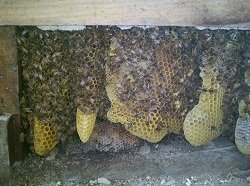Bee Keeping – Keeping the world growing
Bee Keeping is all about raising bees and keeping this world growing.
Honey bees are some of the world’s number one pollinators, and without them the world as we know it would not exist. Keeping bees is one of the most rewarding, interesting, and enjoyable activities I have ever done. Anyone, anywhere can be a beekeeper, it’s not just a country past time. Bees are needed even in the city!
So, what’s involved in being a beekeeper?
Bee keeping has many facets of involvement, and never ceases to present the beekeeper [beek] with something new to learn. Just when you think you are starting to get it all figured out, the bees will show you something you have never seen, or another beek will show you a different way of beekeeping that you never thought of.
Raising & Feeding
Raising bees may be a misnomer for beekeeping, because it is
really the bees in the honey bee hive that do the raising. We just provide a comfortable place for them
to do it. Basically the bee keeper keeps the ladies warm and well-fed, and they do all the work.
Hive Types
Many types of hives have been used over hundreds of years for beekeeping. Some include Skeps [illegal in the US], Langstroth, Cheshire, Cowan, WBC, British National, and Dartington to name just a few. Langstroth Hives,
developed in 1852, are the most widely used around the world today for honey bee
keeping. They were developed with "Bee Space" in mind to keep down excess comb building in the hive, provide efficient use of space in the hive, and make the harvesting of honey more efficient.
Clothing & Equipment
Beekeeping requires special clothes [to help keep the beek from the inevitable stings] and equipment that go with the trade. Veil, gloves, and bee suit are all vital pieces of beekeeping clothing for the beekeeper. The smoker, hive tool, and other tools are used to inspect the honey bee hives and discover how the bees are fairing. Feeders, screen bottom boards, and other items may be employed to make the colony stronger.
Pests & Parasites
If pests and parasites are present, Integrated Pest Management [IPM] can be applied to help control them. Small hive beetles, wax moths, varroa mites, and tracheal mites are some of the main pests that afflict the honey bees and their hives.
Beekeeping is an art that never grows old and always presents something new to learn. Ask any “older” beek and he will tell you that beekeeping has changed and you can’t keep bees the way his father did. With the ever increasing mobility in the world, the spread of pests and parasites will continually change the way we work with keeping bees.
And, with the ever changing building methods, removing bees from a structure will always present new challenges. Besides these two inevitable changes, sometimes bees just do things that you have never seen before, and that’s what keeps beekeeping interesting!
List your favorite or find a new one to try!


If you see bees going in and out of a structure, you may be in for a surprise as to what is behind the wall.